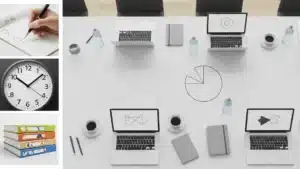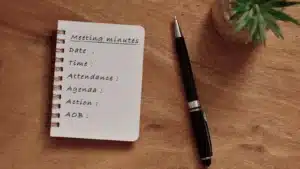
How to Write a Meeting Agenda Format That Actually Matters
In today’s fast-paced work environment, meetings can often feel like a necessary evil. However, a well-structured meeting agenda can transform a chaotic gathering into a productive session. Crafting an effective meeting agenda format is essential for ensuring that all participants are on the same page and that the meeting objectives are met. This article will explore the essential components of a meeting agenda, how to create one that resonates with participants, and tips for maximizing its effectiveness.
The Importance of a Meeting Agenda
A meeting agenda serves as a roadmap for the discussion, guiding participants through the topics that need to be covered. Without a clear agenda, meetings can easily veer off track, leading to wasted time and frustration. Here are a few reasons why having a well-defined agenda is crucial:
- Focus: An agenda keeps the meeting on topic, ensuring that all relevant issues are addressed.
- Preparation: Participants can prepare in advance for the topics to be discussed, leading to more informed contributions.
- Time Management: Setting a time limit for each agenda item helps keep the meeting within the allotted timeframe.
Enhancing Engagement
A clear agenda not only organizes the meeting but also enhances engagement among participants. When attendees know what to expect, they are more likely to contribute meaningfully. Additionally, a structured agenda can help to manage dominant personalities, allowing quieter members to share their insights. This balance fosters a more inclusive environment where diverse perspectives can thrive, ultimately leading to more innovative solutions and ideas.
Setting Expectations
By distributing the agenda ahead of time, participants can align their expectations with the meeting goals. This transparency fosters a sense of accountability and encourages everyone to come prepared to discuss their assigned topics. Furthermore, sharing the agenda in advance allows team members to identify areas where they may need additional information or clarification, enabling them to seek out relevant resources or consult with colleagues prior to the meeting. This proactive approach not only enhances the quality of the discussion but also empowers participants to take ownership of their contributions.
Encouraging Accountability
Another significant benefit of a well-crafted agenda is its role in promoting accountability among team members. By clearly outlining who is responsible for each agenda item, participants are more likely to take their commitments seriously. This clarity helps to ensure that all voices are heard and that each person understands their role in the broader context of the meeting. Moreover, when individuals know they will be called upon to report on their progress or share insights, they are more likely to follow through on their tasks, leading to a more productive and results-oriented meeting atmosphere.
Facilitating Follow-Up
Finally, a detailed agenda can serve as a valuable reference point for follow-up actions after the meeting concludes. By documenting decisions made and assigning action items during the meeting, the agenda can help track progress and ensure accountability moving forward. This practice not only reinforces the importance of the discussions held but also provides a framework for future meetings, allowing teams to build on previous conversations and maintain momentum toward their goals. In this way, a well-structured agenda becomes an essential tool not just for the meeting itself, but for the ongoing collaboration and success of the team.
Key Components of a Meeting Agenda
Creating a meeting agenda involves several critical components that ensure clarity and effectiveness. Here are the essential elements to include:
1. Title and Purpose
The meeting title should be clear and concise, reflecting the main objective. Following the title, a brief statement of purpose can provide context and set the tone for the meeting. This helps participants understand the significance of the gathering and what is expected of them. A well-defined purpose not only streamlines the discussion but also aids in keeping the meeting focused, preventing it from veering off into unrelated topics.
2. Date, Time, and Location
Always include the date, time, and location of the meeting at the top of the agenda. This information is crucial for ensuring that all participants can attend and arrive on time. If the meeting is virtual, include the link to the video conference platform. Additionally, consider noting the time zone, especially for meetings involving participants from different regions, as this can help avoid confusion and ensure everyone joins at the correct time.
3. Attendees
List the names of expected attendees, along with their roles or departments. This helps participants understand who will be present and whom they might need to collaborate with during the meeting. It also allows for better preparation, as attendees can reach out to others for insights or information before the meeting. Including a brief note on the responsibilities of each attendee clarifies expectations and encourages active participation, ensuring that everyone comes prepared to contribute meaningfully to the discussion.
4. Agenda Items
Detailing the specific topics to be discussed is crucial for a productive meeting. Each item should have a designated time slot, allowing for a structured flow of conversation. This not only keeps the meeting on track but also ensures that all necessary points are covered. Additionally, assigning a lead for each agenda item can enhance accountability and encourage thorough preparation, as the designated individual will be responsible for presenting the topic and facilitating discussion.
5. Action Items
At the end of the agenda, it can be beneficial to include a section for action items. This serves as a reminder of tasks that need to be completed post-meeting and assigns responsibility for each task to specific individuals. By clearly outlining these action items, participants can leave the meeting with a clear understanding of their next steps, which helps maintain momentum and accountability in achieving the meeting’s objectives. Including deadlines for these tasks can further enhance follow-through and ensure that progress is made in a timely manner.
Structuring the Agenda Items
Once the foundational elements are in place, the next step is to structure the agenda items. This section contains the bulk of the content and should be organized logically to facilitate discussion.
Prioritize Topics
Start with the most critical topics to ensure that they receive adequate attention. This prioritization can help manage time effectively, ensuring that essential issues are addressed even if the meeting runs longer than expected. It’s also beneficial to consider the interests and concerns of the participants when determining the order of topics. Engaging stakeholders early in the agenda can foster a collaborative atmosphere and encourage more active participation throughout the meeting.
Time Allocation
Assign a specific time frame for each agenda item. This time allocation encourages focused discussions and helps keep the meeting on track. Consider using a table format to present this information clearly:
Agenda Item | Time Allocated
|
|---|---|
Introduction and Purpose | 5 minutes |
Project Updates | 15 minutes |
Discussion on Challenges | 20 minutes |
Next Steps | 10 minutes |
Additionally, it may be useful to build in buffer time between agenda items. This allows for any overflow from discussions and gives participants a moment to regroup before moving on to the next topic. Having a designated timekeeper can help manage these transitions smoothly, ensuring that the meeting maintains its momentum while respecting everyone’s time.
Assign Roles
Identifying who will lead each agenda item can enhance accountability and ensure that discussions remain productive. Clearly delineate roles such as facilitator, note-taker, or timekeeper to streamline the meeting process. The facilitator should be someone skilled in guiding discussions, encouraging participation, and keeping the group focused on the agenda. Meanwhile, the note-taker plays a crucial role in capturing key points and action items, which can be invaluable for follow-up after the meeting. It may also be beneficial to rotate these roles in subsequent meetings to develop skills across the team and keep engagement levels high.
Furthermore, consider assigning a ‘devil’s advocate’ role for certain discussions, especially when tackling contentious issues. This person can challenge ideas and assumptions, prompting deeper analysis and ensuring that all perspectives are considered. By fostering an environment where diverse opinions are welcomed, the meeting can lead to more innovative solutions and a stronger team dynamic.
Tips for Creating an Effective Agenda
While the structure of the agenda is vital, additional tips can enhance its effectiveness. These strategies can help ensure that the agenda serves its purpose and contributes to a successful meeting.
Be Concise
Keep the agenda items brief and to the point. Avoid jargon or overly complex language that may confuse participants. A concise agenda is easier to digest and allows attendees to quickly understand the topics at hand.
Encourage Input
Before finalizing the agenda, solicit input from key stakeholders. This collaborative approach not only fosters inclusivity but also ensures that all relevant topics are covered. Participants may have valuable insights or additional items that should be included.
Follow Up with Minutes
After the meeting, send out the minutes that summarize the discussions and decisions made. This follow-up reinforces accountability and provides a reference for participants to review. Including a link to the agenda in the minutes can also help attendees recall the original discussion points.
Adapting the Agenda for Different Types of Meetings
Different types of meetings may require varying agenda formats. Understanding the unique needs of each meeting type can help tailor the agenda accordingly.
Team Meetings
For regular team meetings, the agenda can focus on project updates, team performance, and any challenges that need addressing. Incorporating a section for team feedback can also foster a collaborative atmosphere.
Client Meetings
Client meetings often require a more formal agenda that emphasizes relationship building and project alignment. Include sections for client feedback, project milestones, and next steps to ensure that both parties are aligned on expectations.
Brainstorming Sessions
In brainstorming sessions, the agenda should encourage creativity and open dialogue. Instead of rigid time allocations, consider using flexible timeframes to allow for deeper exploration of ideas. Include prompts or questions to stimulate discussion among participants.
Utilizing Technology for Agenda Creation
In the digital age, various tools can assist in creating and distributing meeting agendas. Leveraging technology can enhance the process and improve accessibility for all participants.
Collaboration Tools
Platforms like Google Docs or Microsoft Teams allow for real-time collaboration on agenda creation. Participants can contribute their thoughts and suggestions, ensuring that the final agenda reflects a collective input.
Agenda Templates
Utilizing pre-designed agenda templates can save time and ensure consistency across meetings. Many project management tools offer customizable templates that can be tailored to specific meeting needs.
Calendar Integration
Integrating the agenda with calendar invites ensures that all participants have easy access to the meeting details. This integration can also send reminders, helping to reduce the likelihood of no-shows.
Best Practices for Distributing the Agenda
Effectively distributing the agenda is as important as creating it. How the agenda is shared can impact how well it is received by participants.
Send in Advance
Distributing the agenda at least 24 hours before the meeting allows participants sufficient time to prepare. This advance notice can lead to more productive discussions, as attendees come equipped with relevant information.
Use Clear Subject Lines
When sending the agenda via email, use a clear and informative subject line. This helps recipients immediately recognize the purpose of the email and prioritize it accordingly.
Encourage Acknowledgment
Requesting a simple acknowledgment from participants can ensure that everyone has received the agenda. This step can help identify any potential scheduling conflicts or concerns before the meeting begins.
Evaluating the Effectiveness of the Agenda
After the meeting, it is essential to evaluate the effectiveness of the agenda. Gathering feedback can provide insights into what worked well and what could be improved for future meetings.
Solicit Feedback
Encourage participants to provide feedback on the agenda structure and content. This can be done through a quick survey or informal conversation. Understanding their perspectives can help refine the agenda for future meetings.
Analyze Meeting Outcomes
Assess whether the meeting objectives were met. Did the discussions lead to actionable outcomes? Were participants engaged? Analyzing these factors can help determine the agenda’s overall success.
Make Adjustments
Based on the feedback and outcomes, adjust the agenda format for future meetings as needed. Continuous improvement is key to maximizing the effectiveness of meeting agendas.
Plan with Purpose
A meaningful agenda does more than organize time—it sets the stage for focused, collaborative progress. When meetings start with clarity and structure, teams stay aligned, engaged, and action-oriented. PresEngage makes it easy to craft agendas that drive outcomes, boost accountability, and keep participation high. Start your 14-day free trial and lead smarter meetings.
Present Smarter. Engage Answer Convert Close Remarkably.
Dazzle your audience with Real-Time Q&A powered by your AI Co-Presenter.(Patent Pending)
PresEngage™ makes you look brilliant by connecting with everyone, instantly.
No Credit Card Required. 100% Risk Free.
Frictionless Audience Experience GUARANTEED.







